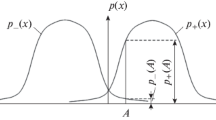Abstract
This paper investigates the performance of a new Turbo Trellis Coded Modulation scheme over correlated flat fading channels with channel interleaving. The novelty of the scheme is based on the application of a new modified transition metric incorporated in the symbol-by-symbol MAP algorithm. We consider frequency non-selective, slow Rayleigh fading channels. Extensive simulation results together with EXIT chart analysis show that the proposed scheme achieves better performance compared to the conventional transition metric when channel state information is not available at the decoder.
Similar content being viewed by others
References
P. Robertson and T. Wörz, “Bandwidth-Efficient Turbo Trellis-Coded Modulation Using Punctured Component Codes”, IEEE Journal on Selected Areas in Communications, Vol. 16, No. 2, pp. 206–218, Feb. 1998.
I. Nissopoulos, C. Dimakis and S. Kouris, “The Effect of Metric Modification on the Performance of TCM and Concatenated Systems over Rayleigh Fading Channels”, International Journal of Wireless Information Networks, Vol. 7, No. 3, pp. 167–174, 2000.
C. Berrou, A. Glavieux, and P. Thitimajshima, “Near Shannon Limit Error-Correcting Coding and Decoding: Turbo Codes”, in Proceedings of IEEE International Conference on Communications, Geneva, Switzerland, May 1993, pp. 1064–1070.
S. ten Brink, “Convergence Behavior of Iteratively Decoded Parallel Concatenated Codes”, IEEE Transactions on Communications, Vol. 49, pp. 1727–1737, Oct. 2001.
C. Dimakis and K. Koutsouvelis, “Turbo Trellis Coded Modulation with Modified Transition Metric for Rayleigh Fading Channels”, in Proceedings of the 4th International Symposium CSNDSP, Newcastle, UK, July 2004, pp. 253–255.
S. Benedetto, D. Divsalar, G. Montorsi, and F. Pollara, “Parallel Concatenated Trellis Coded Modulation”, in Proceedings of the IEEE International Conference on Communication, Dallas, USA, June 1996, pp. 974–978.
A. Grant, “Convergence of Non-Binary Iterative Decoding”, in Proceedings of the IEEE Globecom, San Antonio, USA, Nov. 2001, pp. 1058–1062.
Author information
Authors and Affiliations
Corresponding author
Additional information
Kostas V. Koutsouvelis was born in Thessaloniki, Greece, on July 16,1970. He received the degree Diploma in Electrical Engineering from Aristotle University of Thessaloniki, Greece in 1996 and the Master degree in Satellite Communications Engineering from University of Surrey in 1997.
From 1998 to 2003 he was involved in the development of V5.2 interface as a senior software designer in Intracom plc. In 2004 joined the research and development division of Hellenic Telecommunication Organization (OTE) and his also PhD candidate at Aristotle University of Thessaloniki working with Turbo codes and Turbo Coded Modulation.
Christos E. Dimakiswasborn in Serres, Greece, on July 27, 1955.He received the degree Diploma in Electrical Engineering from the Aristotle University of Thessaloniki, Greece, in 1980. Working in the satellite communications and in the error correcting coding area he received his PhD degree in digital telecommunications from the Aristotle University of Thessaloniki, Greece, in 1994.
In 1980 he joined the Department of Electrical Engineering, Telecommunications Division of the Aristotle University of Thessaloniki as a research fellow. Since 1997 he is a lecturer of digital communications at the same University. Presently, his research interests include digital modulations, coding theory, satellite and mobile communications and system simulation.
Stamatis S. Kouris was born in Corfu, Greece. He received the degree of Doctor Engineer in Electrical Engineering from the University of Rome, Italy and the Diploma of Specialization in Telecommunications of the Instituto Superiore, University of Rome, in 1960 and 1963 respectively. In 1971 he was awarded the PhD Degree of the University of Edinburgh, UK. In the 1974 he was awarded a specialization Diploma in administration from the University of Pomona CA, USA. He is a member of the Technical Chamber of Greece, URSI, IRI and other organizations. Since 1964 he has been involved in research on radio-propagation, antennas and microwaves, working mainly at the Fondazione Bordoni, Italy, University of Edinburgh, UK and University of Thessaloniki, Greece. He has published several papers on radio-propagation, antennas, communication transmission and microwaves and millimeter-waves devices. In 1976 he joined with the Department of Electrical Engineering, School of Engineering Science, Aristotle University of Thessaloniki. He served as professor of telecommunications from 1978 to 2002. Since 2002 he is an emeritus professor.
Rights and permissions
About this article
Cite this article
Koutsouvelis, K.V., Dimakis, C.E. & Kouris, S.S. Turbo Trellis Coded Modulation with Enhanced Transition Metric over Rayleigh Fading Channels. Wireless Pers Commun 35, 311–320 (2005). https://doi.org/10.1007/s11277-005-6771-0
Issue Date:
DOI: https://doi.org/10.1007/s11277-005-6771-0




